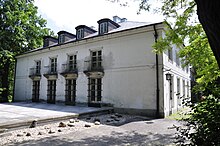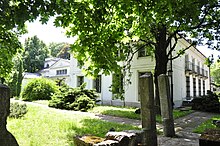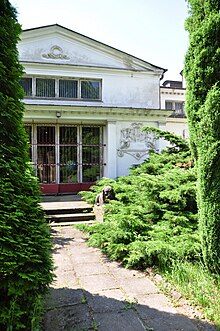Frascati Palace
| Frascati Palace | ||
|---|---|---|
|
Front facade |
||
| Creation time : | after 1750 | |
| Castle type : | palace | |
| Conservation status: | Reconstructed | |
| Place: | Warsaw | |
| Geographical location | 52 ° 13 '44 " N , 21 ° 1' 43" E | |
|
|
||

The Frascati Palace in Warsaw (also known as the White Palace or Branicki-Lubomirski-Palais , Polish: Biały Pałacyk na Frascati or Pałacyk Branickich-Lubomirskich ) is located above the Vistula embankment in the inner city district and is now used as a museum.
history
In the second half of the 18th century, Prince Kazimierz Poniatowski had a park created by Simon Gottlieb Zug with the name “Auf der Höhe” (Polish: “Na Górze”), which referred to the steeply sloping Vistula embankment. In 1779 Zug also built a wooden summer palace. A separate kitchen building belonged to the building. At the beginning of the 19th century, the wooden structure was replaced by a brick low-rise building and connected to the kitchen. Under the then owner, the French restaurateur Simon Chovot, the former summer residence was converted into a restaurant. He renamed the garden of the complex as “Frascati Park”, based on the landscape around the small Italian town of Frascati . As a result, the property changed hands several times: the deputy governor Nikolai Novossilzew and the Polish general in Russian service Józef Rautenstrauch lived here.
In the second half of the 19th century, the property was acquired by Countess Róża Potocki-Branicka (1780–1862). Alfons Ferdynand Kropiwnicki converted the building from 1836 to 1838. Under Maria's grandson, Władysław Branicki, Leander Marconi built a new “Red Palace” (because of its red clinker cladding ; later referred to as the Branicki Palace ) near the old building, now known as the “White Palace” . For the marriage of the Branicki daughter Maria to Zdzisław Lubomirski, the bride and groom were given the “White Palace” as a residence, the Branicki parents stayed in the neighboring “Red Palace”. In Lubomirski's time there were many important guests visiting the palace: Józef Piłsudski , Kazimierz Sosnkowski , Bogdan von Hutten-Czapski , Charles de Gaulle , Hugo von Hofmannsthal and Carl Gustaf Emil Mannerheim . At that time there were around 20 rooms in the classically designed, irregular building, including a two-story ballroom and a winter garden.
After the death of Maria Lubomirska, who died in the palace, her husband moved into a nearby, smaller villa. The palace was rented as a residence to the ambassador of China until 1939. In the war , the building was damaged. In 1948 the restoration and, in some cases, significant redesign, took place as part of the Museum der Erde under the direction of the architects Zbigniew Karpiński and Tadeusz Zieliński.
Today the palace has the address Aleja na Skarpie 20/26 . Previous addresses were Aleja Legionów 20/26 and Ulica Wiejska 10 .
See also
References and comments
- ↑ not to be confused with the White House in Łazienki Park
- ^ Józef Rautenstrauch (1773–1842) was an officer in Polish and Russian services
Web links
- Historical photos at Warszawa1939.pl
- Brief information at Warszawa Wikia (in Polish)
- Brief information at Kierunekpolska.pl (in Polish)
literature
- Julius A. Chroscicki and Andrzej Rottermund, Architectural Atlas of Warsaw , 1st edition, Arkady, Warsaw 1978, p. 174




